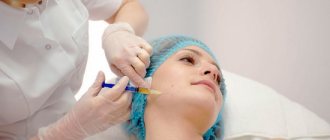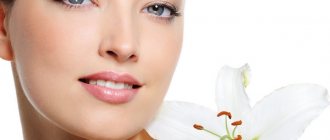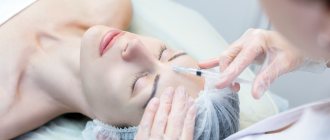Features of Botox rejuvenation
Botulinum therapy is a method of facial rejuvenation that involves injecting botulinum toxin (botulism neurotoxin type A) under the skin. In fact, it is a strong poison, but the one in the preparation is diluted 40,000 times. And in small doses it does not pose a danger to human health.
The effect of Botox is local - it affects the muscles located at the injection site. By acting on nerve endings, botulinum toxin stops the transmission of motor impulses to the brain, which causes temporary muscle paralysis. Relaxed muscles limit facial expressions, and the less facial expressions, the fewer wrinkles.
Temporary blocking of muscles with botulinum toxin reduces the expression of facial expressions, which helps smooth out existing wrinkles and slows down the appearance of new ones.
The effect of Botox develops in the first 2-3 days after the procedure, but fully manifests itself on days 10-14. Lasts 4-8 months - the period for maintaining the result is individual. The mobility of facial muscles returns gradually with the appearance of new processes of nerve endings. During the blockade period under the influence of Botox, muscle atrophy does not occur.
The botulinum therapy procedure itself lasts about 20 minutes and does not cause severe pain - only a slight tingling and tingling sensation at the injection sites. A specialist cosmetologist determines the necessary areas and makes injections in them. 10-200 units of botulinum toxin are administered in one session. The price of one unit is 300-600 rubles.
Combination rules
Cosmetologists do not recommend simultaneous injections of different drugs into a single area. This can lead to inadequate functioning of the substances and complications.
Performing the procedure using drugs with different mechanisms of action is possible when affecting remote areas. Is it possible to carry out a complex procedure at once? The doctor will definitely say.
When treating a single area, cosmetologists recommend first performing Botox injections. After 14–30 days, correction is carried out or the area is supplemented with the required amount of filler. This scheme will allow you to efficiently remove even large wrinkles.
It is possible to change the order of use of drugs, but it is difficult to make an optimal calculation of the required amount of substances. Often, the result of this type of procedure disappears faster or the patient suffers complications.
Advantages and disadvantages of Botox
The method of facial skin rejuvenation using botulinum toxin injections until a few years ago was used mainly only by movie and show business stars. But now this procedure is popular among ordinary people, and both women and men resort to it. Botulinum therapy has a number of advantages compared to other methods of skin rejuvenation:
Advantages
- quick effect without surgery;
- no rehabilitation period - immediately after the injections you can lead a normal lifestyle without any restrictions;
- does not cause severe pain;
- should be repeated no more often than once every 6-10 months;
- the procedure takes no more than 15-20 minutes;
- prevents skin aging and the appearance of new deep expression wrinkles.
Flaws
- unnatural facial expressions are possible due to muscle weakness;
- unable to cope with deep folds;
- less pronounced and short-lasting effect in athletes.
Too high doses of the drug can cause ptosis (drooping eyelids, eyebrows, lips), difficulties with blinking, swallowing or chewing food, and a complete disturbance of facial expressions (mask effect). Moreover, correcting these changes is quite difficult.
ANALOGUES OF THE DRUG
In addition to Botox, botulinum toxin-based drugs such as Dysport and Xeomin are now common on the cosmetic market. Basically, the drugs differ in the dosage of botulinum toxin and resistance to changing storage conditions.
Estimated consumption of Botox, Dysport, Xeomin
| Impact area | Botox | Dysport | Xeomin |
| Forehead | 5-30 units. | 15-90 units. | 10-20 units. |
| Between the eyebrows | 15-30 units. | 45-90 units. | 10-20 units. |
| Eye area | 10-20 units. | 30-60 units. | 16-24 UNITS |
| Nose area | 2-10 units. | 6-30 units. | 4-6 units. |
| Lip area | 4-16 UNITS | 12-48 UNITS | 2-4 units. |
| Neck, décolleté | from 60 units. | from 180 units. | from 60 units. |
| Axillary areas | 60-200 units. | 180-600 units. | 100-200 units. |
Features of rejuvenation with fillers
The word filler comes from the English. infill, which means to fill. This is the essence of the method of rejuvenation using fillers - the correction of cosmetic skin defects using an injectable filler drug. Most often, hyaluronic acid or collagen is used, but fillers made from synthetic polymer gels or your own adipose tissue are sometimes used. Getting into the soft tissues, the filler has a lifting effect on the skin, fills wrinkles and folds, reducing visible manifestations. Often used to eliminate facial wrinkles.
Fillers are also used to add volume to soft tissues, to correct the shape of the lips, nose or chin, and for facial asymmetry. The procedure for introducing fillers under the skin in cosmetology is called filling. It is considered an alternative and safest option for contouring.
There are many types of fillers with different densities and active ingredient contents. The cosmetologist chooses the optimal drug depending on the area and the problems being solved. It is injected deep under the skin using a syringe with a microscopic needle or cannula. The procedure is quite painful and lasts about 30-40 minutes. With the introduction of biodegradable fillers (based on hyaluric acid and collagen), the result of skin rejuvenation lasts for 6-10 months. Silicone gels have a permanent effect.
The cost of filling depends on the amount of the drug injected and the correction zones, and therefore varies significantly. Price 1 ml from 3500 to 12000 rubles.
Contraindications
Despite the safety of this rejuvenation technique, there are a number of contraindications to its implementation:
· autoimmune and oncological diseases, diabetes mellitus, chronic diseases during exacerbation
diseases associated with blood clotting
· colds (flu, acute respiratory infections, acute respiratory viral infections)
· herpes in the acute stage
allergic reactions to drugs used in fillers
· pregnancy and lactation period
· skin damage in the correction areas
· recently performed other cosmetic procedures: peelings, photorejuvenation, techniques involving laser effects on facial skin
Advantages and disadvantages of filling
It’s not for nothing that filler injections are called “beauty injections” - indeed, after the procedure, the face almost immediately takes on a fresh look, wrinkles, scars, scars and other imperfections on the face become invisible. Fillers not only rejuvenate the skin, but can also correct the anatomical shape of the nose, lips, cheekbones and chin. This is why filleting is so popular among women and men all over the world.
Advantages
- can be carried out at any time of the year - fillers do not increase the photosensitivity of the skin and do not provoke pigmentation;
- metabolic processes in the deep layers of the epidermis are activated, which has a beneficial effect on the condition of the skin;
- the possibility of correcting the unsuccessful result of a previous procedure - repeated injection of fillers helps eliminate facial asymmetry.
Flaws
- the procedure is quite painful, and the use of anesthesia causes additional swelling in the facial area;
- long recovery period – up to 2 weeks;
- when an excessive amount of filler is introduced, the face or its elements may lose its anatomically correct shape and look unnatural;
- since filler is a foreign body, rejection and allergic reactions sometimes occur;
- synthetic fillers can migrate in facial tissues, cause skin inflammation and fibrosis - the growth of connective tissue with the appearance of scars;
- hyaluronic acid sometimes provokes the formation of benign tumors from adipose and connective tissue;
- If fillers are distributed incorrectly, lumps may form under the skin.
The introduction of fillers by certified cosmetologists reduces the risk of side effects. But it is impossible to completely insure against them. You need to carefully weigh the pros and cons before deciding to fill.
Opinion of cosmetologists
Doctors actively use both versions of drugs in their work. Cosmetologists carry out prescriptions according to the situation: some patients are more suitable for botulinum toxin, for others modeling with hyaluronic gels. Sometimes a combination of techniques is indispensable. In this case, injections must be done sequentially.
The cosmetologist suggests using drugs to correct different areas.
The cosmetologist suggests sequential use of medications.
The cosmetologist offers an integrated approach.
Similarities and differences
Both Botox and fillers are actively used to rejuvenate facial skin, both among women and men. These methods have some similarities:
- both are injectable - drugs are injected under the skin using a syringe with a very thin needle;
- cannot be called completely safe for health - sometimes they cause complications and side effects;
- in case of excessive administration of drugs, the face or some of its areas may look unnatural;
- the rejuvenation effect lasts 8-10 months;
- not recommended for people under 35 years of age and for the first acquaintance with injection rejuvenation.
Cosmetologists always advise starting to fight the first signs of facial skin aging with massages, peeling, mesotherapy or biorevitalization procedures. Botox and fillers are the heavier artillery that should be reserved for eliminating deep wrinkles and folds when other rejuvenation methods are no longer effective.
This is where the similarities between filling procedures and botulinum therapy end. There are much more differences between them:
- different composition of injections;
- the effect of Botox injections is based on temporary paralysis of the facial muscles, which leads to muscle relaxation and smoothing of shallow facial wrinkles, while fillers add volume and fill deep folds in the skin;
- Botox does not affect the condition of the skin, the filler changes the volume and improves the condition of the epidermis;
- Botox is used mainly to correct the upper area of the face, fillers - any part;
- the result of the filler injection procedure is noticeable immediately; after botulinum therapy, 10-14 days should pass for a visible effect;
- filling can be used to correct lips, nose, and facial asymmetry, including in young people and girls;
- botulinum therapy has a preventive effect - it reduces the formation of facial wrinkles in the future, however, the procedure is not carried out to prevent signs of skin aging, only to eliminate existing changes;
- after the Botox procedure there are no restrictions and a long recovery period; after fillering, it is imperative to follow a number of restrictive measures for two weeks;
- Botox injections are cheaper than fillers.
For a more clear comparison of the features, advantages and disadvantages of both methods, we suggest that you familiarize yourself with the table.
INDICATIONS FOR ADMINISTRATION
Elimination and smoothing of wrinkles:
- Horizontal wrinkles on the forehead;
- Vertical wrinkles between the eyebrows;
- Oblique wrinkles on the bridge of the nose (they are also called “rabbit wrinkles”);
- Wrinkles at the outer corner of the eye;
- Upturned or low eyebrows;
- Pronounced nasolabial folds;
- Vertical and horizontal neck wrinkles;
- Treatment of hyperhidrosis, severe sweating of the palms, feet, and armpits;
- Non-surgical face lift, the so-called Botox lift.
comparison table
| Comparison criterion | Botox | Fillers |
| Composition of the drug for injection | Botulinum toxins | Hyaluronic acid, collagen, synthetic gels or your own adipose tissue |
| Operating principle | Blocks the transmission of nerve impulses from facial muscles, relaxes them, eliminates facial wrinkles | Replenishes lack of tissue volume, fills wrinkles and deep folds |
| Effect on skin condition | Has no effect | Improves metabolic processes in the epidermis |
| What problems does it solve? | Correction and reduction of expression wrinkles mainly in the upper area of the face | Correction of the shape and volume of the lips, nose, chin, cheekbones, elimination of deep wrinkles and folds on the entire surface of the face |
| Recommended age | From 35 years old | From 18 years old for facial correction, from 40 years old – for rejuvenation |
| When does the result appear? | Within 10-14 days | Immediately after the procedure |
| Duration of the recovery period | 1 day | Up to 12-14 days |
| Severity of painful sensations during injections | Minor | Significant |
| Duration of effect after procedure | 6-10 months | 8-12 months |
| How often is it recommended to carry out | No more than once every six months, so as not to cause addiction | Once every 6-18 months as the filler dissolves |
| Price | Depends on the volume of the drug administered and the number of zones to be corrected - on average 5-15 thousand rubles. | Depends on the number of zones to be corrected and the cost of the drug - 10-50 thousand rubles. |
Why do nasolabial folds form?
Let's say right away: do not confuse a nasolabial fold with a skin crease - these are two similar, but different in genesis problems.
Nasolabial fold
Nasolabial folds, in fact, have been with us since childhood - they simply appear only during facial activity (for example, smiling).
The main and most common cause of the formation of a nasolabial fold is the overhang of the nasolabial fat packet diagonally from the nostrils to the corners of the mouth during facial activity - both in childhood and in adults.
If all the fat packets are in place , then in a calm state the folds are not visible. But with age, the nasolabial fat packet “slides” down, and it is this that forms the fold itself.
If nasolabial folds appear from a young age, the reason is still the same - hypertrophied volume of the nasolabial fat packet.
The main reason for the formation of nasolabial folds is overhanging fat bags, no matter what they tell you on the Internet! Not skin, not muscle, but a fat packet.
Yes, the problem can be aggravated by the anatomical structure (deep-set oral region, malocclusion), the activity of the zygomatic minor and major muscles (they are responsible for the smile), but the contribution of these factors to the formation of the fold itself is insignificant.
Nasolabial skin fold
But the crease on the skin is formed due to the active work of the zygomatic muscles!
Every time we smile, scream and other emotions, we develop nasolabial depression. The constantly “creased” skin in this area - like paper - can become wrinkled over time: a skin crease.
Young skin is elastic and elastic, which means it easily recovers from wrinkles, but after 30 years, the production of elastin and collagen slows down and skin turgor decreases. It is after 30 years a skin fold usually begins to form in the area of the nasolabial fold .
A number of anatomical reasons - a narrow, long face, a deep-set oral area - contribute to the appearance of a crease, often without the appearance of the crease itself.
After 35-40 years, a combination of the fold itself (with an overhanging fat packet) and a skin crease is often observed.











